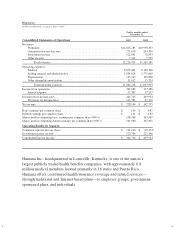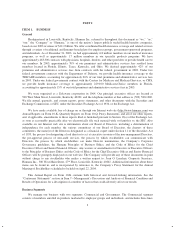Humana 2003 Annual Report Download - page 18
Download and view the complete annual report
Please find page 18 of the 2003 Humana annual report below. You can navigate through the pages in the report by either clicking on the pages listed below, or by using the keyword search tool below to find specific information within the annual report.
and premature infant care, asthma related illness, end stage renal disease, diabetes, and breast cancer screening.
We also may focus on certain rare conditions where disease management techniques benefit members in a more
cost effective manner.
We typically contract with hospitals on either a per diem rate, which is an all-inclusive rate per day, a case
rate, which is an all-inclusive rate per admission, or at a discounted charge for inpatient hospital services.
Outpatient hospital services generally are contracted at a flat rate by type of service or at a discounted charge.
These contracts are often multi-year agreements, with rates that are adjusted for inflation annually based on the
consumer price index or other nationally recognized inflation index. Outpatient surgery centers and other
ancillary providers typically are contracted at flat rates per service provided or are reimbursed based upon a
nationally-recognized fee schedule such as the Medicare allowable fee schedule.
Our contracts with physicians typically are automatically renewed each year, unless either party gives
written notice to the other party of their intent to terminate the arrangement. Most of the physicians in our PPO
networks and some of our physicians in our HMO networks are reimbursed based upon a fixed fee schedule,
which typically provides for reimbursement based upon a percentage of the standard Medicare allowable fee
schedule.
Capitation
For 7.1% of our December 31, 2003 medical membership, we contract with hospitals and physicians to
accept financial risk for a defined set of HMO membership. In transferring this risk, we prepay these providers a
monthly fixed-fee per member, known as a capitation payment, to coordinate substantially all of the medical care
for their capitated HMO membership, including some health benefit administrative functions and claims
processing. For these capitated HMO arrangements, we generally agree to reimbursement rates that target a
medical expense ratio ranging from 82% to 89%. Providers participating in hospital-based capitated HMO
arrangements generally receive a monthly payment for all of the services within their system for their HMO
membership. Providers participating in physician-based capitated HMO arrangements generally have
subcontracted directly with hospitals and specialist physicians, and are responsible for reimbursing such hospitals
and physicians for services rendered to their HMO membership.
For 6.4% of our December 31, 2003 medical membership, we contract with physicians under risk-sharing
arrangements whereby physicians have assumed some level of risk for all or a portion of the medical costs of
their HMO membership. Although these arrangements do include capitation payments for services rendered, we
process substantially all of the claims under these arrangements.
Physicians under capitation arrangements typically have stop loss coverage so that a physician’s financial
risk for any single member is limited to a maximum amount on an annual basis. We remain financially
responsible for health care services to our members in the event our providers fail to provide such services.
10
























